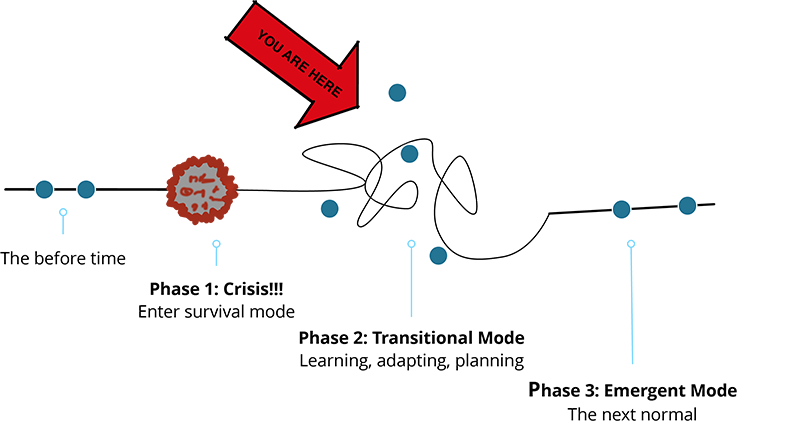How to Run a Strategic Pivot Meeting with Your Team
How is your organization going to survive and thrive in the emerging economy?
That’s the question on everyone’s mind right now.
Later when we look back, it will seem so clear. Our grandchildren will shake their heads and say:
“If I was alive back then, I totally would have….”
And then the smug little darlings will fill in the blank with whatever proves to be so very obvious in hindsight. Whatever that is, it’s not so obvious now.
All we have are clues. Historic events that share some of the same patterns. Bits and pieces of evidence that, if we could just summon enough inner Sherlock, we could see a perfectly correct, elementary solution.
We have a fogged-over, dirty window of opportunity. We can’t see what’s on the other side of this window, and we’re racing towards the future at full speed.
We have no choice but to move forward into this uncertainty. We can’t wait for the answers, because if we do, we’ll miss the opportunity to be a part of creating those answers.

Ok, so that’s the call to action, and I’m nowhere close to the first person to sound this call. This call is everywhere, and–lucky you, lucky me!–every consultant out there has a service offering ready to help us answer that call.
But here’s the thing. Small business leaders like you, and like me and my partners, we know that the decisions about what to do next are our responsibility. We’re in the best position to understand what we can and cannot take on. We know our teams, we know our markets, and while we’d LOVE magical mentorship fairies that would just give us the answers, we know that both our budgets and the time we have to make these hard choices are limited.
To sum up the situation for small business and organization leaders:
- You don’t know what’s coming, but you can see that things won’t just go back to the way they were before. Not any time soon, at least.
- You need a new plan for your organization now.
- You have to create that plan with your team. No one else is going to do it for you.
The critical question: How are you going to do that?
The Gift of Well-Framed Questions and Useful Examples
We’re all trying to create a plan for an unknowable future that makes the best of our uncertain resources for an unreliable customer base. That’s a nasty blank-slate problem.
We were looking for a way to frame our thoughts on this. Then one day, Angelique Rewers at The Corporate Agent posted a list of planning questions for her private community of small business owners. For small businesses and for the big businesses we serve, these are the questions that matter right now.
- How can we keep money coming in?
- How and where can we save money?
- How can we keep our operations running?
Then for each of the three questions, she listed several possible high-level strategies. For example, when seeking ways to increase revenue, she suggested that businesses could:
- Retain existing customers
- Gain new customers
- Increase prices
- Increase the frequency with which customers buy
- Introduce new products or services (up-sells, cross-sells, new economy-priced options)
- Incentivize pre-payment or annual contracts
- Accelerate projects planned for later in the year
- Obtain new lines of credit, loans, grants, or investments
- Sell assets such as stocks, buildings, divisions, geographic regions, equipment, etc.
Then she asked: What are some ways you could do these things in your business? How might you help others do these things for their businesses, creating new opportunities for you?
It was like water in the desert. Suddenly all these leaders who were paralyzed with too many options and too much uncertainty had somewhere to start. For each question, they could look at the examples and brainstorm several ideas specific to their business and team.
When you’re facing stressful decisions, it’s really, really useful to start with a simple process and concrete examples. That’s why I’m thrilled that Angelique agreed to let us use her examples in this new meeting template.
Thank you, Corporate Agent!
Creating a New Strategy with Your Team
The Corporate Agent’s framing questions and examples helped individuals brainstorm all kinds of ideas. If you’re a solopreneur, grab your mind maps and lists and sticky notes and go for it!
Those of us running teams can take this a step further by combining several people’s ideas to create a new action plan.
Building on these three framing questions, we designed a meeting template that will guide you and your team as you plan your strategic pivot.
The Agenda
- Greetings and Goals
- Situation Briefing: What’s real right now?
- Predictions: What do the indicators suggest about our future?
– Break –
- Revenue: How can we keep money coming in?
- Expenses: How and where can we save money?
- Resilience: How can we keep our operations running?
– Long Break –
- Reconvene: What else?
- Quick Wins: What’s easy that we should just do?
- Top Priorities: Which projects should we prioritize right now?
– Break –
- Plan Next Steps: Who will do what by when?
- Closing: Review and Appreciations
I’ve put together a download bundle that includes a complete step-by-step facilitator’s guide, a worksheet you can use to prepare for the meeting featuring Angelique’s great examples, and some tips for running this meeting online.
How this Meeting Works
This meeting is designed to be run by business leaders with their teams. We’ve included a few simple exercises to keep the discussion running smoothly and to help you get through all of it in a reasonable amount of time. You don’t need any fancy facilitation skills to run this one, although if you have those skills, please feel free to substitute your favorite activities for the ones we’ve chosen.
The keys to success with this meeting are:
- preparation, and
- tackling the topics in order.
Your team must come prepared to share insights and ideas they’ve generated on their own. That way you can learn from everyone’s unique perspective (and not just group think). The topic order is designed to make sure your team arrives at the crucial decision-making stage well-informed and loaded with a plethora of best available options.
This meeting starts by examining the evidence. You and your team will discuss what you know about the case (i.e., the current state of your business) and any clues you’ve gathered in your search for a successful path to a bright future.
After going over what you know to be true and what you suspect, you’ll then share all your ideas for the three questions: ways to increase revenue, decrease expenses, and keep the lights on. You’ll discuss these ideas to make sure you understand them, and then you’ll take a big, long break.
During that break, everyone will consider what they’ve heard. They’ll chew on those niggling questions while they chew on some food, and they’ll scribble down new insights that suddenly come to them. If you have the time to let everyone sleep on these ideas and literally dream about the possibilities, even better.
After the long break, you’ll come back and share any new epiphanies. Then, you’ll make some decisions.
The first decisions will be easy. Identifying quick wins will move your team from the mushy “what if” stage into action mode, warming them up for the bigger decisions you’ll make next.
You may find that even the big choices you need to make are hair-on-fire obvious, which will make this second half of the meeting go really fast.
It’s more likely, though, that you’ll find yourselves in the groan zone. This is that hard, messy part of a meeting where you’re trying to narrow down your options to those few that you’ll put into action. When that groaning begins, take a deep breath and let everyone else know that it’s a totally normal part of the process. You’ll get through it.
What You Get at the End
When you finish the meeting, your team will have:
- A shared understanding of what changed in your business and what the new strategy needs to accomplish
- Insights into leading indicators that inform your new strategy
- A new list of strategic priorities
- A near-term action plan
- Ideas about other things you could try if this plan doesn’t work
- Commitment to the new plan
As you can see, this is a longer meeting that will take most teams four to six hours to complete, not including the breaks. It also requires everyone to show up prepared with ideas, which deserves at least another hour of everyone’s time.
While that may seem like a big time commitment, it’s actually amazingly fast. By following this guide, your team could have a new plan within the next two days, putting you way ahead of the competition.
Or, you could wait until your schedule clears. Based on the number of empty storefronts and “out of business” signs I saw go up in our neighborhood this week, it looks like lots of people have schedules that are clearing up in a big way.
I hope that whatever happens next for you and your team, it works out in a way that will make your grandchildren proud. If you think running this meeting with your team might be one useful way to make that future a reality, you can download it for free below.



